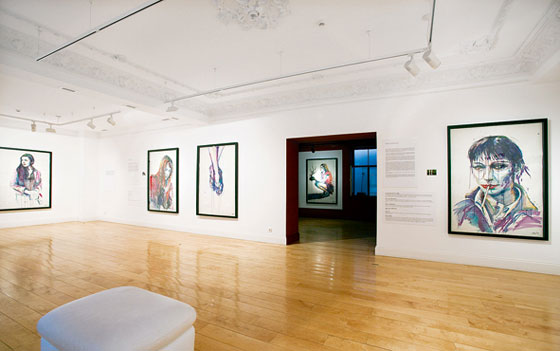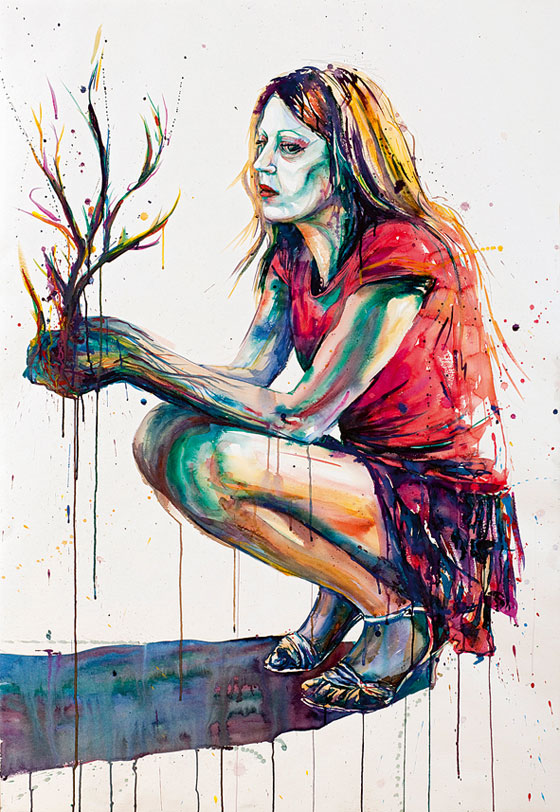|
|
| Brekte’s challenge Sniedze Sofija Kāle, Art Historian Kristians Brekte. Riga Madonnas 25.10.–17.12.2010. Alma Gallery | |
| Riga Madonnas is a very interesting project by two individuals – artist Kristians Brekte and curator Ieva Kulakova – presented at the Alma Gallery from 25 October to 17 December. | |
 Kristians Brekte. Exhibition 'Riga Madonnas'. Partial view from exposition. 2010. Photo: Didzis Grodzs | |
| Until now, the artistic praxis of Kristians Brekte has been closely connected with his reputation as a scandal-maker and rebel. The subjects and elements he chooses often arouse a storm of discussion and protest, since they hit the mark precisely, drawing the vigilant attention of people with more conservative views, the guardians of ethical standards. And what can be more flattering than an irate upholder of morals going on the attack, striving to reinforce and defend their shaky convictions? Evidently, the rebel artist has managed to uncover the hypocritical nature of this morality. That which is truly alive and genuine cannot be under threat or in need of protection. Students, on noticing a small Nazi swastika on the breast of the girl depicted in the painting Zilais lakatiņš [‘The Blue Scarf’], recoiled in horror as if from the Devil and managed to banish the work from the joint exhibition of artists at the university. The Valmiera city officials, although they did not suffer the death in one minute that Kristians Brekte had promised, were no less angry and ordered that the banner be removed. The list of provocative works and scandals they have caused could be continued, but in every case the same very telling scenario is repeated, which shows that Brekte is endowed with an intuitive capacity for detecting the weak spots in our society’s beliefs. Thus, for example, the recent solo exhibition by the artist Morgs [‘The Morgue’] at the 1. stāvs Gallery in 2008, featured photographs of roadkill and other dead animals in boxes: death illuminated. It is a natural thing. After all, people, too, suffer various kinds of sudden death, but the interest in animal rights which has increased to an unwholesome level in the West was also echoed in the reaction of visitors to the exhibition. For consolation, it should be added that we still haven’t reached the level of animal rights campaigners in France: in 2010, when Belgian artist Wim Delvoye exhibited stuffed and tattooed pigs in the Museum of Modern and Contemporary Art in Nice, threats followed that the exhibition would be sabotaged in protest. This time Brekte has chosen another subject that vexes society: prostitution. However, this is the least provocative solo exhibition in his creative biography yet. Here the contribution of Ieva Kulakova, co-creator of the exhibition, should be mentioned. The artist himself invited the art historian to participate because he wished to add a further dimension to the heroines of his exhibition. This is very successfully achieved and thus the accompanying text also becomes an object of the visitor’s attention (evaluation). As a result, the exhibition is not limited to exterior portraits of these members of society, “gloating” about the fate of “fallen” women, but instead permits quite a comprehensive insight into their inner world. | |
 Kristians Brekte. Samanta. Watercolour on paper. 174x120 cm. 2010. Publicity photo | |
| The documentary and investigative content of the exhibition provides the opportunity of reaching a couple of interesting conclusions. Thanks to the questions raised, visitors can learn ordinary, recognisable details, such as someone’s favourite book or film (and, by the way, it can’t be an accident that three out of seven randomly selected prostitutes named as their favourite book Mikhail Bulgakov’s ‘The Master and Margarita’), or existential fears (for example, death or the loss of someone close), and what they believe in (God, higher forces, or complete non-belief), which are familiar and intelligible to all, regardless of social status. The viewer’s empathy is stirred by Kulakova’s impassioned accounts of the women’s life stories, which share the same testimony of demands imposed by a cruel fate (a partner who had died or left, or other conditions that have left women’s families and children without subsistence) – the decisive factors that have led them to earn a living on the street. The motivation of the “Riga madonnas” – to feed their child, or to provide support for their mother, or to enable a brother or sister to attend school – is the same that causes thousands of Latvians to leave their own country in order to earn money abroad. It’s only that these women have chosen the quickest way to get money. An act of desperation later develops into routine, and two of the stories testify that it is possible to escape; however, few manage to fight the “moral hangover” without drowning in alcohol or succumbing to the oblivion of drugs. The abyss alongside which the heroines of the exhibition tread their everyday path is terrifying. To look into it does not mean taking pleasure in observing the life stories of these strangers from a distance, but rather it means a reacquaintance with the sneering face of desperation, which every one of us has encountered at some point. The curator of the exhibition shares her personal feelings in the comments, heightening the overall dramatic effect of the exhibition, and this is enhanced by the visualised images by Kristians Brekte. | |
 Kristians Brekte. Aleksandra I. Watercolour on paper. 174x120 cm. 2010. Publicity photo | |
| The extensive texts, although set out on traditional white backgrounds, dominate over the visual material of the exhibition. Brekte has successfully chosen the most appropriate medium for portraying the “madonnas”: the fragile lines and murky washes of watercolour act as a direct analogy for the essence of these women. However, not in every case are they able to match the tensely emotional information in the text, although the portraits Alexandra I, Kitija and Samanta do achieve this harmony of unison. Possibly because the fragmentary composition of the other works does not correspond to the main idea behind the exhibition: “A wish to approach the revelation of heightened sensuous individuality.” Instead, they seek to avoid it, utilising the “fortuitous” technique of documenting reality, which is widely used in contemporary art. The same applies to the photographs, which show realistic details, but the artist should not be reproached. The intended concept (that the “madonnas” would record “the providers of positive impulses” using a disposable camera) is realised in only two cases, unfortunately. This does prove a powerful approach, giving the viewer the possibility to approach even closer to the way of life of the protagonists in the exhibition. The large-scale watercolours by Kristians Brekte are engaging as independent works of art: they are visually powerful and convincing. However, to what extent they succeed in revealing the main idea behind the exhibition, i.e. to idealise the “Riga madonnas” in question, is another matter. The exhibition may be regarded as a certain evolution of the artist’s intentions, nevertheless his instinct as an investigator of form and intuitive provocateur does seem more truthful than the peredvizhniki(1) approach. (1) Group of Russian realist artists, often called The Wanderers in English /Translator into English: Valdis Bērziņš/ | |
| go back | |







